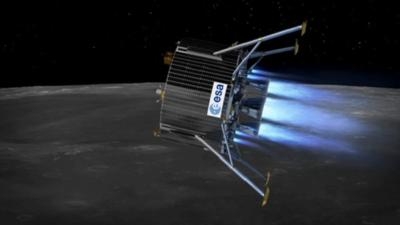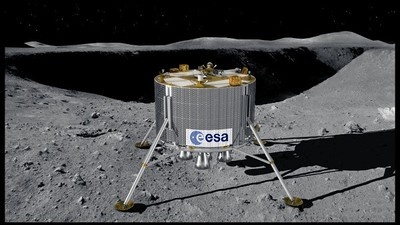Mon, Mar 12, 2012
Touchdown Planned For Moon's South Pole By 2018
Europe’s ambition of touching down at the Moon’s south pole by 2018 has been boosted by recent test firings of the craft’s thrusters. The robot lander will prove new techniques for sending humans to the Moon and assess lunar hazards. With no atmosphere on the Moon, Lunar Lander cannot rely on parachutes to slow its descent. Instead, the craft will need to fire its engines in a rather unconventional way.

One of these thrusters was recently put through its paces at Astrium’s specialised facility in Lampoldshausen, Germany. The test chamber was configured to reproduce the vacuum and temperatures that Lunar Lander will face on its way down to the Moon’s surface. A complete descent and touchdown was simulated, with the thruster firing in a series of short bursts, reaching a white-hot 1100ºC. According to ESA’s Bérengère Houdou, the results are positive: “The thruster operations were smooth and stable, with great performance, even under the stress of Lunar Lander’s operating conditions.”
To save the cost of developing a new engine, ESA engineers looked to the tried-and-tested thrusters of Europe’s proven Automated Transfer Vehicle (ATV) space ferry. ATV has already completed two fully automated missions to the International Space Station, delivering supplies and boosting the complex to a higher orbit. The third ATV is set for launch this month.

But landing on the Moon is very different from docking with a space station. Before these tests, it was unclear whether the thrusters would be suitable for a lunar voyage. Ahead of landing, the craft will orbit the Moon some 100 km above the surface. To descend to the Moon’s southern pole, central engines will fire for 10 minutes as the ATV thrusters steer the spacecraft to a safe landing. There is no GPS for the Moon, so Lunar Lander will navigate by digitally imaging the surface and recognising features. A laser will complete the picture to avoid hazards such as boulders and craters at the target site.
Lunar Lander’s powerful processor will make intelligent decisions to search for a safe area and touch down without human help. European technology will be used throughout. (Images provided by ESA)
More News
He Attempted To Restart The Engine Three Times. On The Third Restart Attempt, He Noticed That Flames Were Coming Out From The Right Wing Near The Fuel Cap Analysis: The pilot repor>[...]
Make Sure You NEVER Miss A New Story From Aero-News Network Do you ever feel like you never see posts from a certain person or page on Facebook or Instagram? Here’s how you c>[...]
From 2009 (YouTube Edition): Leading Air Show Performers Give Their Best Advice for Newcomers On December 6th through December 9th, the Paris Las Vegas Hotel hosted over 1,500 air >[...]
Aero Linx: NASA ASRS ASRS captures confidential reports, analyzes the resulting aviation safety data, and disseminates vital information to the aviation community. The ASRS is an i>[...]
“For our inaugural Pylon Racing Seminar in Roswell, we were thrilled to certify 60 pilots across our six closed-course pylon race classes. Not only did this year’s PRS >[...]
 NTSB Final Report: Rutan Long-EZ
NTSB Final Report: Rutan Long-EZ ANN FAQ: Turn On Post Notifications
ANN FAQ: Turn On Post Notifications Classic Aero-TV: ICAS Perspectives - Advice for New Air Show Performers
Classic Aero-TV: ICAS Perspectives - Advice for New Air Show Performers ANN's Daily Aero-Linx (06.28.25)
ANN's Daily Aero-Linx (06.28.25) Aero-News: Quote of the Day (06.28.25)
Aero-News: Quote of the Day (06.28.25)




